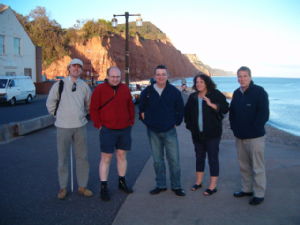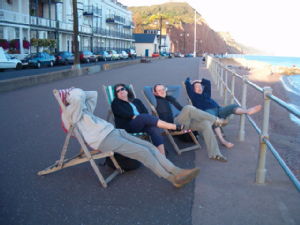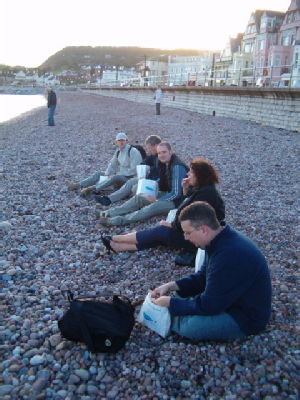All entries for Wednesday 15 September 2004
September 15, 2004
elab & CAP e–learning trip to Sidmouth
After today's proceedings the elab e-learning team with Mark Childs and Graham Lewis from CAP went off to Sidmouth for a few hours by the sea.

Our erudite discussion of learning technologies was punctuated by some time spent lounging in deck-chairs in the sun…

...and a round of fish and chips.

Rhonda rocks
Writing about an entry you don't have permission to view
And to see the evidence, refer to Steve B's blog linked to above.Emergent semantics (from Deleuze) and the semantic web
Follow-up to Bergson's intuition and reflection in learning from Transversality - Robert O'Toole
Following from that is the semantic theory developed by Deleuze in the Logic of Sense. Meaning works as follows. There is an emerging 'problem' space constituted by the way in which different foldings work against each other. And there is the 'solution' which is a second layer of articulations that repeatedly succeeds in operating on the problem space. This second level is itself a problem space requiring solutions (and so on). The applicability of one problem space onto another as a solution is the site of meaning. The twin articulations make sense of each other. Of course the articulations are not entirely seperate, transversal interactions occur between them, complicated feedback loops shift the relationships between the articluations, and hence change their formations.
This raises a question about the semantic web, which attempts to move us to a model for linking content that works with these emergent semantic processes. The idea seems to be this. A document is the static representation of a web of meaning (problem spaces and solutions interacting with each other). That web of meaning is seen to come from the author. A so called 'intelligent agent' is capable of drawing out and representing these meanings with some kind of schema that links them up with other documents and makes them accessible to others using the same schema.
Such a system was demonstrated in the key note speech this morning. It was admitted that the information structure into which the documents are mapped is no different to a database schema, the advantage lying in the data harvesting tools that can do the job more efficiently than manual approaches. It should be obvious that, considering Deleuze's work on meaning, this is an extremely pale imitation of the dynamic transversal relationship that actually takes place in semantics, in the creation and interpretation of documents. The semantic web could allow the reader of a document to identify a web of significant elements themselves, and then seek connections outside that work with that web. Instead, such systems are prejudging the significance of words within the text, applying a set schema, and linking only to other documents that can be similarly analysed. Nothing creative can come of this.
Perhaps a better approach would be to allow the reader to create their own conceptual map of the significant elements of a document, and then search for other simlar maps that apply to other documents. That really would be a semantic web.
Bergson's intuition and reflection in learning
…negative freedom is the result of manufactured social prejudices where, through social institutions, such as education and language, we become enslaved by 'order-words' that identify for us ready-made problems which we are forced to solve. This is not 'life', and it is not the way life itself has 'creatively' evolved. Therefore, true freedom, which can only be a positive freedom, lies in the power to decide through hesitation and indeterminacy and to constitute problems themselves.
Ansell Pearson, Germinal Life, Routledge 1999, p.23
This 'experimental and ethical pedagogy' (ibid, p.14) employs the Bergsonian method of intuition, which involves a reflection on the difference manifest in creative thought. When one realises that a currently held concept simply could not have existed nor could have been analytically deduced at a previous time in a previous state, one gets a sense of time as pure difference, despatialized. That feeling is creative, and the philosophical method that draws people into this reflection is Bergson's intuition. Only once the reliance on ready-made problems is abandoned can creativity occur.
The word 'implication' has a special meaning in this. Imagine reality as a large sheet of fabric. The fabric is folded to present you with one aspect, which you may grasp at. The fold (French – pli) is an aspect. You struggle to hold onto that fold, and find that you can only do so by holding onto other folds that follow on to it. As you try to grasp other folds, to unfold the folds, to follow the im-pli-cations, your actions on the further folds cause the first fold to be pulled and distorted in your grip. Out of this feedback loop the specific problem of this set of folds emerges. At some point you are able to stabilise the folds in relation to each other, and have a solution.
When you grasp the fact that a new problem has emerged, that the positing of the problem is beyond your control, and that you must evolve in relation to the problem in a way that was previously both unthinkable and impossible, you have intuition in Bergson's sense. Intuition is a reflection on learning, a creative learning.
And that's why Deleuze makes such a big issue out of the role of fabric in baroque art (le Pli, Leibniz and the Baroque), the role of the curtain in the paintings of Bacon (Logic of Sensation), and the relationship between canvas, paint and brush-stroke.
 Robert O'Toole
Robert O'Toole

 Please wait - comments are loading
Please wait - comments are loading

